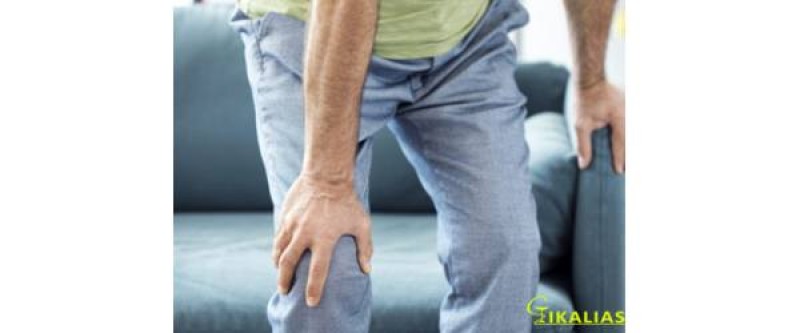Δωρεάν αποστολή για παραγγελίες άνω των 49.00€

Πόνοι στα γόνατα: Όλες οι πιθανές αιτίες για να ξέρετε πώς θα ανακουφιστείτε
Ένας πόνος στο γόνατο είναι ένα πολύ συχνό πρόβλημα που επηρεάζει ανθρώπους όλων των ηλικιών.
Οι πόνοι στα γόνατα μπορεί να είναι το αποτέλεσμα ενός τραυματισμού, αλλά και κάποιας πάθησης, όπως αρθρίτιδα, ουρική αρθρίτιδα και λοιμώξεις.
Πολλοί τύποι ήσσονος σημασίας πόνων στα γόνατα ανταποκρίνονται καλά σε απλά μέτρα φροντίδας στο σπίτι. Η φυσικοθεραπεία και οι ειδικοί επίδεσμοι που συγκρατούν και υποστηρίζουν το γόνατο μπορεί να βοηθήσουν σημαντικά στην ανακούφιση των πόνων. Σε ορισμένες περιπτώσεις, όμως, το γόνατό σας μπορεί να απαιτεί χειρουργική αποκατάσταση.
Πόνοι στα γόνατα: Πιθανές αιτίες
Ένας πόνος στο γόνατο μπορεί να προκληθεί από τραυματισμούς, μηχανικά προβλήματα, αρθρίτιδα και άλλα προβλήματα. Οι τραυματισμοί είναι απλός και προφανής λόγος για τον πόνο στο γόνατο. Στις υπόλοιπες περιπτώσεις, όμως, μπορεί να συμβαίνει κάτι από τα παρακάτω.
Πόνοι στα γόνατα: Μηχανικά προβλήματα
Μερικά παραδείγματα τέτοιων προβλημάτων, που μπορούν να προκαλέσουν πόνους στα γόνατα, περιλαμβάνουν:
• Τραυματισμός/Μικροκάταγμα. Μερικές φορές ο τραυματισμός, ή η εκφύλιση των οστών, ή του χόνδρου στο γόνατο, μπορεί να οδηγήσουν σε σπάσιμο/αποκοπή ενός πολύ μικρού κομματιού οστού, ή χόνδρου στο σημείο της άρθρωσης. Αυτό δεν δημιουργεί κανένα πρόβλημα, παρά μόνο στην περίπτωση που το αποκομμένο κομμάτι έρχεται σε επαφή και εμποδίζει την κανονική κίνηση της άρθρωσης και του ποδιού. Σε αυτή την περίπτωση το κομμάτι αυτό προκαλεί πόνο, επειδή είναι σαν ένα μολύβι που έχει κολλήσει στους μεντεσέδες μιας πόρτας και την εμποδίζει να κλείσει.
• Σύνδρομο λαγονοκνημιαίου συνδέσμου. Αυτό συμβαίνει όταν το σκληρό κομμάτι ιστού (σύνδεσμος) που εκτείνεται από το εξωτερικό του ισχίου σας προς την εξωτερική πλευρά του γονάτου (λαγονοκνημιαίος σύνδεσμος) γίνεται τόσο σφιχτός, ώστε φτάνει τρίβεται πάνω στο εξωτερικό τμήμα του μηρού σας. Οι δρομείς μεγάλων αποστάσεων είναι ιδιαίτερα ευαίσθητοι στο σύνδρομο λαγονοκνημιαίου συνδέσμου.
• Εξάρθρωση επιγονατίδας. Αυτό συμβαίνει όταν το τριγωνικό οστό (επιγονατίδα) που καλύπτει το μπροστινό μέρος του γονάτου σας βγαίνει εκτός θέσης και “γλιστρά” συνήθως προς το εξωτερικό του γονάτου σας. Σε ορισμένες περιπτώσεις, η επιγονατίδα μπορεί να παραμείνει εκτοπισμένη και θα είστε σε θέση να δείτε την εξάρθρωση εξωτερικά.
• Πόνος στο ισχίο ή στο πόδι. Αν έχετε πόνους στο ισχίο ή το πόδι, είναι πιθανό να αλλάξετε και τον τρόπο που βαδίζετε για να μειώσετε αυτούς τους πόνους. Αλλά αυτή ακριβώς η αλλαγή στο βάδισμα μπορεί να ρίξει μεγαλύτερο σωματικό βάρος στην άρθρωση του γονάτου σας, καθώς το σώμα ισορροπεί.
Πόνοι στα γόνατα: Αρθρίτιδα
Υπάρχουν πάνω από 100 διαφορετικοί τύποι αρθρίτιδας. Τα είδη που είναι πιθανότερο να επηρεάσουν το γόνατο περιλαμβάνουν:
• Οστεοαρθρίτιδα. Μερικές φορές ονομάζεται και εκφυλιστική αρθρίτιδα και είναι ο πιο κοινός τύπος αρθρίτιδας. Είναι μια κατάσταση φθοράς που εμφανίζεται όταν ο χόνδρος στο γόνατο επιδεινώνεται με τη χρήση και το πέρασμα των ετών.
• Ρευματοειδής αρθρίτιδα. Είναι η πιο “εξουθενωτική” μορφή αρθρίτιδας. Πρόκειται για μια αυτοάνοση πάθηση που μπορεί να επηρεάσει σχεδόν κάθε άρθρωση στο σώμα σας, συμπεριλαμβανομένων των γονάτων σας. Παρά το γεγονός ότι η ρευματοειδής αρθρίτιδα είναι μια χρόνια νόσος, τείνει να ποικίλει σε σοβαρότητα και μπορεί ακόμη και να “έρχεται και να φεύγει” ανά περιόδους.
• Ουρική αρθρίτιδα. Αυτό το είδος της αρθρίτιδας συμβαίνει όταν κρύσταλλοι ουρικού οξέος συσσωρεύονται στην άρθρωση. Αν και η ουρική αρθρίτιδα συνήθως επηρεάζει το μεγάλο δάκτυλο του πέλματος, μπορεί επίσης να εμφανιστεί στο γόνατο.
• Ψευδοουρική αρθρίτιδα. Συχνά συγχέεται με την ουρική αρθρίτιδα, αλλά η ψευδοουρική αρθρίτιδα προκαλείται από κρυστάλλους που περιέχουν ασβέστιο και οι οποίοι αναπτύσσονται μέσα στο αρθρικό υγρό. Τα γόνατα είναι το πιο σύνηθες σημείο του σώματος που επηρεάζεται από αυτό τον τύπο αρθρίτιδας.
• Σηπτική αρθρίτιδα. Μερικές φορές η άρθρωση του γονάτου σας μπορεί να μολυνθεί, κάτι που οδηγεί σε πρήξιμο, πόνο και ερυθρότητα. Η σηπτική αρθρίτιδα συχνά συνοδεύεται από πυρετό.
Άλλα προβλήματα
Το σύνδρομο επιγονατιδομηριαίου πόνου είναι ένας γενικός όρος που αναφέρεται στον πόνο που προκύπτει μεταξύ της επιγονατίδας και του υποκείμενου μηριαίου οστού (μηρός). Είναι συχνό πρόβλημα σε αθλητές, σε νεαρούς ενήλικες, ιδιαίτερα εκείνους που έχουν μια μικρή δυσπλασία της επιγονατίδας και σε ενήλικες μεγαλύτερης ηλικίας, οι οποίοι συνήθως αναπτύσσουν την πάθηση ως αποτέλεσμα της αρθρίτιδας στην επιγονατίδα.
Πηγή: https://www.iatropedia.gr/ , http://www.mayoclinic.org














